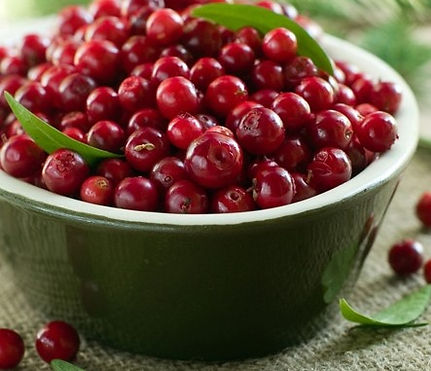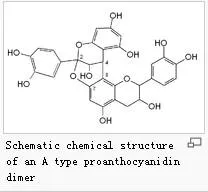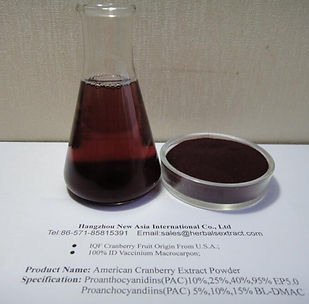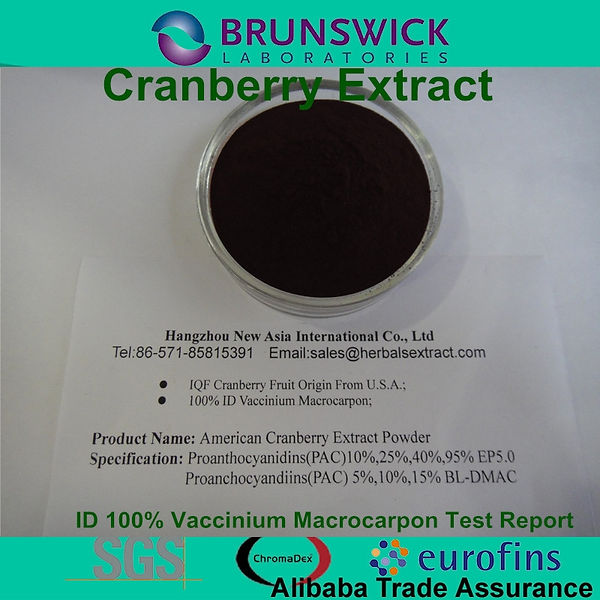

IQF American Cranberry Origin from U.S.A,Canada
-
American Cranberry Extract Technical Data Sheet
Common Name:
Scientific Name:
Other Names:
Part Used:
Specification:
Manufacturer Certificate Available:
H.S.Code:
CAS:
Molecular formula:
Molecular weight:
EINECS:
INCI Name:
Molecular Structure:
American Cranberry Extract
Vaccinium Macrocarpon L
Cranberry Extract,
IQF Cranbery Fruit Origin from U.S.A and Canada
PACs 5%,25%,40%,95% UV Measured by European Pharmacopoeia 5.0 PACs 5%,10%,15% Measured by BL-DMAC
ISO9001,ISO22000,KOSHER,HALAL
1302.19
91770-88-6
C15H11O6
287.25
294-875-8
Vaccinium Macrocarpon (Cranberry) Fruit Extract
Sort by Product Function

Cranberry is a native evergreen shrub that grows throughout North America.
Historically, cranberry fruits or leaves were used for bladder, stomach, and liver disorders, as well as diabetes, wounds, and other conditions.
Today, cranberry is used as a dietary supplement primarily for urinary tract infections (UTIs).
The berries are used in beverages and food. They are also made into dietary supplements in the form of extracts, powder, capsules, and tablets.
Only cranberry contains unique A-type PAC with strong antiadhesion activity against certain E.coli bacteria.
In 2004 the French agency AFSSA (now Anses) approved a health claim for cranberries with 36 milligrams of PAC to “help reduce the adhesion of certain E. coli bacteria to the urinary tract walls”, and subsequently fight urinary tract infections (UTIs).
PACs are small molecules (catechin or epicatechin) molecules linked together to form larger polymers. The PACs in cranberries contain a high proportion of what are called ‘A-type double linkages’ between the catechin or epicatechin molecules.
Other food sources of PACs that do not contain these A-type linkages (chocolate, grapes, apples and green tea etc contain B-type proanthocyanidin) do not elicit the bacterial anti-adhesion activity.
a.IQF Cranbery Fruit Origin from U.S.A and Canada -100% ID Vaccinium Macrocarpon L.
*HPLC Chromatograph of American Cranberry Fruit
*cranberry ID report-Anthocyanin Profile Krueger Food Laboratories
b.American Cranberry Extract-100% ID Vaccinium Macrocarpon L.
*HPLC Chromatograph of American Cranberry Extract
*HPTLC Botanical Identity Test Report-Chromadex
-
Contaminants of Cranberry Extract
*PAHs,(Benzo(a)anthracene, Benzo(b)fluoranthene, Benzo(a)pyrene, Chrysene)
*Heavy Metals(As,Pb,Cd,Hg)
*Microbiological Testing ( Total Plate Count, Mold,Yeast)
*Pesticides Residue
-
Nutritional Information Of Cranberry Extract
-
Specification of High Potency Standardized American Cranberry Extract
*PACs 40% Report Measured by European Pharmacopoeia
*PACs 10% Report Measured by BL-DMAC
-
Test Method of PACs in Cranberry Extract





-
American Cranberry Extract Data Download


Above Photo is American Cranberry PACs 3% UV American Cranberry PACs 0.5% BL-DMAC


Above Photo of American Cranberry Extract Good Water Solubility of American Cranberry Extract

-
Why Select Our Cranberry Extract
-
100% ID Vaccinium Macrocarpon L.
-
IQF Cranbery Fruit Origin from U.S.A and Canada
-
Third Party Lab Control for ID,Potency Gurantee
-
Non-Irradiation,Non-GMO,Non-Allergen Gurantee
-
Low Contaminants of Aflatoxin,PAHs,Heavy Metal,Microbiological Gurantee
Our Cranberry Extract is a kind of loose red violet fine powder.The ingredients are produced from the fruit of cranberry which are planted in certified planting base in U.S.A and Canada and process strictly under the rules of international authentication.Original raw material from U.S.A and Canada is with low pesticide,and high value,and high content.
Our cranberry extract powder,100% pure nature nutrient without any additives,and having strong antioxidant compounds.
Our cranberry extract powder,is easy to combine with other mixed powder,and can be widely used in Dietary Supplyment,Beverages and Snacks.
-
Why do people take Cranberry Extract
Preventing urinary tract infections (UTIs).
Some research shows that drinking cranberry juice or taking certain cranberry extracts can lower the risk of repeated UTIs in some people, such as women, children, older people, and people who are hospitalized.
In 2004 the French agency AFSSA (now Anses) approved a health claim for cranberries with 36 milligrams of PAC to “help reduce the adhesion of certain E. coli bacteria to the urinary tract walls”, and subsequently fight urinary tract infections (UTIs).
How much cranberry extract should you take
Daily consumption of the recommended 36mg of cranberry proanthocyanidins (PACs) has shown effectiveness in inhibiting bacteria from adhering to bladder cells, multiplying and consequently causing infection. This amount of PACs can be easily consumed in a 9-10 oz serving of 27% cranberry juice cocktail.
-
What are the risks of taking cranberry extract
Cranberry is LIKELY SAFE for most people when taken by mouth appropriately. Cranberry juice and cranberry extracts have been used safely in people. However, drinking too much cranberry juice can cause some side effects such as mild stomach upset and diarrhea. Drinking more than 1 liter per day for a long period of time might increase the chance of getting kidney stones.
There is not enough reliable information about the safety of taking cranberry for therapeutic reasons if you are pregnant or breast feeding. Stay on the safe side and avoid use.
-
Cranberry PACs test method
Now,many methods exist for the determination of PACs: DMAC, vanillin, Bate-Smith, HPLC, European Pharmacopoeia etc.
In 2004 the French agency AFSSA (now Anses) approved a health claim for cranberries with 36 milligrams of PAC to “help reduce the adhesion of certain E. coli bacteria to the urinary tract walls”, and subsequently fight urinary tract infections (UTIs).
The French health claim refers to 36 milligrams of PACs measured using the 4-dimethylaminocinnamaldehyde (DMAC) method, but AFSSA did not specify which method was valid for the health claim, and this has led to a range of methods being applied.
The method proposed by the European Pharmacopoeia and used by members of EuraCran (European Association for the Valorization of Cranberry Extracts) has been adopted by some players in the French market.
There are also additional methods for measuring PACs available, and they all deliver different results. A common analogy is measuring temperature with Celsius and Fahrenheit – both measures give you the temperature, but not the same value.
Meanwhile, an updated method, called BL-DMAC has been published by the USDA-ARS (Journal of the Science of Food and Agriculture, July 2010, Vol. 90, pp. 1473-1478). All analytical labs previously using DMAC have now switched to this method.

